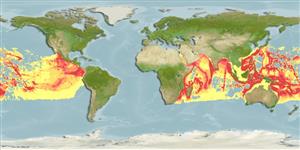Common names from other countries
Classification / Names / Names
ชื่อสามัญ | ชื่อพ้อง | Catalog of Fishes (gen., sp.) | ITIS | CoL | WoRMS
Environment: milieu / climate zone / depth range / distribution range
นิเวศวิทยา
เกี่ยวกับหินโสโครก; ระดับความลึก 0 - 4800 m (Ref. 100946). Tropical; 36°N - 34°S, 26°E - 77°W (Ref. 847)
Indo-Pacific and the Red Sea.
Length at first maturity / ขนาด / น้ำหนัก / Age
Maturity: Lm ? range ? - ? cm
Colonies are composed of stout, upright, flattened branches that are often over one meter across and may for large single species stands. Pale to dark green or brown in color.
Can be found in shallow waters (Ref. 122680). Found in most reef environments (Ref. 847), particularly in fore-reefs (Ref. 87903). Comanthus parvicirrus, a crinoid, is sometimes observed to be wedged on the branches of this species (Ref. 100838).
Life cycle and mating behavior
วัยเจริญพันธุ์ | การสืบพันธุ์ | การวางไข่ | เซลสืบพันธ์ของเพศเมีย(ไข่) | ความดกของไข่ | ตัวอ่อน
Members of the class Anthozoa are either gonochoric or hermaphroditic. Mature gametes are shed into the coelenteron and spawned through the mouth. Life cycle: The zygote develops into a planktonic planula larva. Metamorphosis begins with early morphogenesis of tentacles, septa and pharynx before larval settlement on the aboral end.
Veron, J.E.N. 2000. (Ref. 847)
IUCN Red List Status (Ref. 130435)
CITES status (Ref. 108899)
Not Evaluated
Human uses
| FishSource |
เครื่องมือ
ข้อมูลเพิ่มเติม
Age/SizeการเจริญเติบโตLength-weightLength-lengthสัณฐานวิทยาตัวอ่อนอุดมสมบรูณ์
แหล่งที่มาจากอินเตอร์เน็ต
Estimates based on models
Preferred temperature
(Ref.
115969): 2.5 - 7.2, mean 3.7 (based on 2276 cells).
Price category
Unknown.
